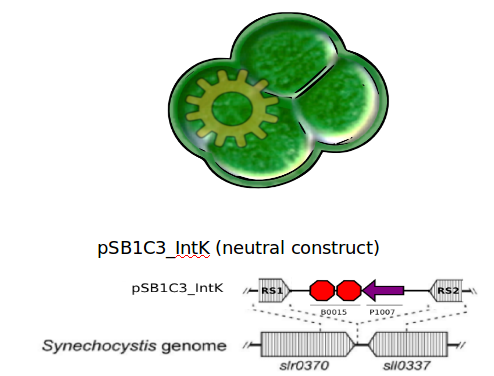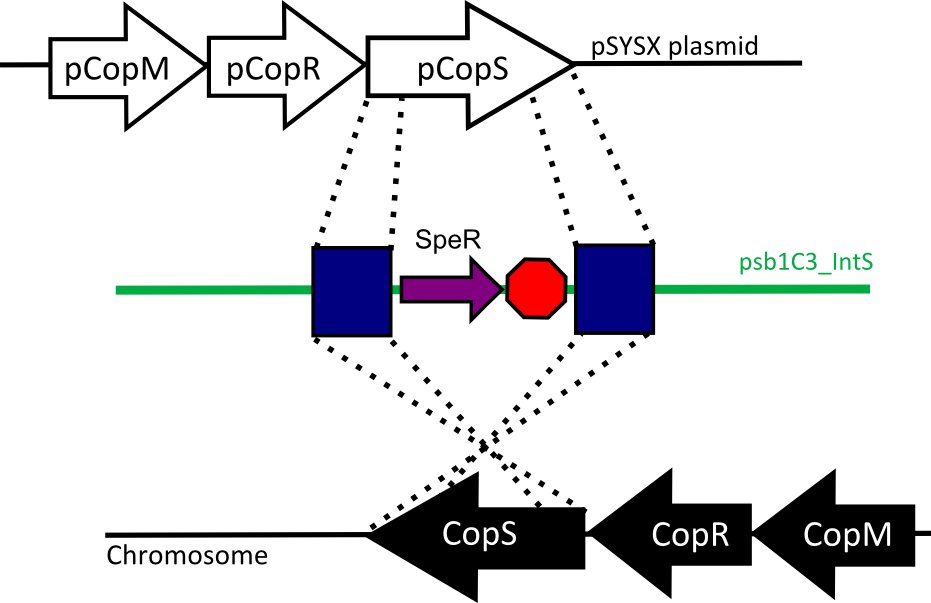Team:UC Chile/Cyanolux/Project short
From 2012.igem.org
(Difference between revisions)
Juan Alamos (Talk | contribs) |
|||
| (14 intermediate revisions not shown) | |||
| Line 53: | Line 53: | ||
<h2>Strategy</h2> | <h2>Strategy</h2> | ||
| - | The limiting step for the bacterial bioluminescent reaction is the substrate (n-decanal) concentration | + | The limiting step for the bacterial bioluminescent reaction is the substrate (n-decanal) concentration, therefore, to control light emission over time we decided to control it´s abundance in the cells, which in our model is a function of the substrates generation (by Lux C, D, E and G enzymes) and consumption (by the LuxAB luciferase). |
<html><center><img src="https://static.igem.org/mediawiki/2012/f/fc/Dospromotorusi.jpg" align="middle" width="850"></center></html> | <html><center><img src="https://static.igem.org/mediawiki/2012/f/fc/Dospromotorusi.jpg" align="middle" width="850"></center></html> | ||
| Line 63: | Line 63: | ||
Our model works as a “black box” in which the input takes the form of a specific hour of the day (i.e the hour on which you want your metabolite to reach maximal concentration) and the output is a couple of promoters from Synechocystis genome. | Our model works as a “black box” in which the input takes the form of a specific hour of the day (i.e the hour on which you want your metabolite to reach maximal concentration) and the output is a couple of promoters from Synechocystis genome. | ||
It assumes that the metabolite's production is controlled by enzymes under the control of promoter 1 and it´s degradation by enzymes under promoter 2. | It assumes that the metabolite's production is controlled by enzymes under the control of promoter 1 and it´s degradation by enzymes under promoter 2. | ||
| - | For more details please check [2012.igem.org/Team:UC_Chile/Cyanolux/Modelling here] | + | For more details please check [https://2012.igem.org/Team:UC_Chile/Cyanolux/Modelling here] |
<html><center><img src="https://static.igem.org/mediawiki/2012/d/db/Blackbox.2.jpg" align="middle" width="660"></center></html> | <html><center><img src="https://static.igem.org/mediawiki/2012/d/db/Blackbox.2.jpg" align="middle" width="660"></center></html> | ||
| Line 72: | Line 72: | ||
As there weren´t straighforward tools to start working with in the registry (i.e characterized plasmids backbones, protocols, etc) we started from scratch. | As there weren´t straighforward tools to start working with in the registry (i.e characterized plasmids backbones, protocols, etc) we started from scratch. | ||
| - | We designed two recombination plasmids backbones. One targets a gene essential for our chassis survival in the environment | + | We designed two recombination plasmids backbones. One targets a gene essential for our chassis survival in the environment [https://2012.igem.org/Team:UC_Chile/Biosafety#Susceptibility_Construct (see biosafety)] and the other one a neutral site. |
| + | |||
[[File:UC_Chile-IntKstrategy.jpg | 480px | left]] | [[File:UC_Chile-IntKstrategy.jpg | 480px | left]] | ||
| Line 108: | Line 109: | ||
| - | [https://2012.igem.org/Team:UC_Chile/Cyanolux/Biolamp Full description of the device here] | + | [https://2012.igem.org/Team:UC_Chile/Cyanolux/Biolamp Full description of the biolamp device here] |
| + | <div style="float:left"> | ||
| + | [https://2012.igem.org/Team:UC_Chile/Cyanolux/Project See more about the whole project] | ||
| + | </div> | ||
| + | <br><br><br> | ||
| + | <html> | ||
| + | <a href="https://2012.igem.org/Team:UC_Chile/Cyanolux/Results_short"><img src="https://static.igem.org/mediawiki/2012/a/ab/UC_Chile-Continue_button.jpg" align="right"> | ||
| + | </html> | ||
| - | |||
| - | |||
| - | |||
{{UC_Chilefooter}} | {{UC_Chilefooter}} | ||
Latest revision as of 03:23, 27 October 2012
 "
"















